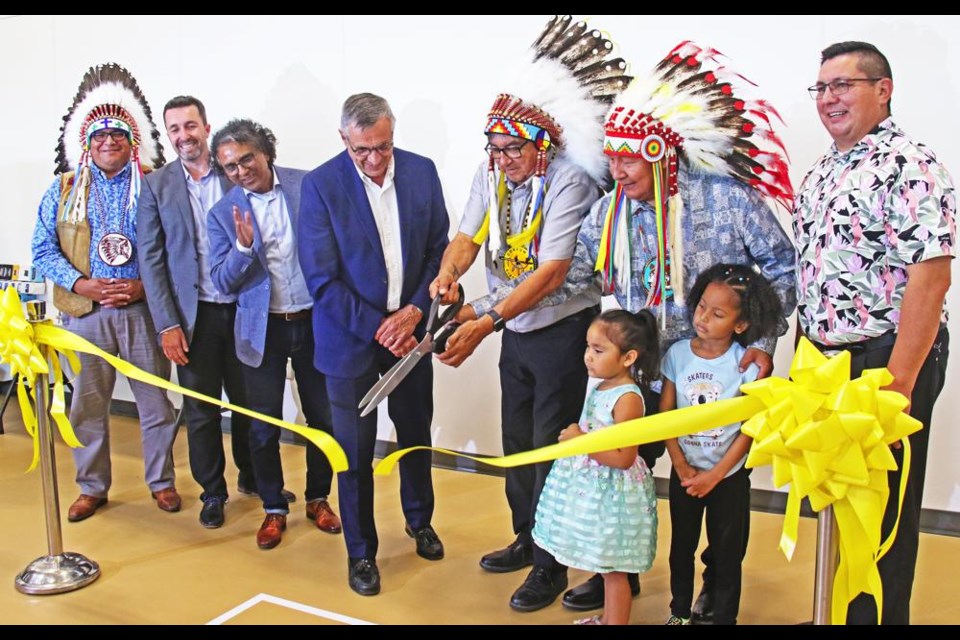WEYBURN – Special ceremonies and gift-giving were held on Tuesday afternoon for the official opening of the Pesâkâstêw Solar Power facility located just southwest of the city in the RM of Weyburn, with representatives from SaskPower, the government, and the two First Nations which are partners in the project.
The ceremonies were held at the Credit Union Spark Centre, and those attending were invited to go to the site of the solar power project to view the facilities. Dignitaries included the chiefs of the two First Nations, minister Don Morgan, SaskPower's new CEO, the vice-chief of the FSIN, and the head of the First Nations Power Authority, along with songs by the Red Dog Singers from Star Blanket Cree Nation.
The 10-megawatt (MW) Pesâkâstêw Solar facility will provide enough clean, renewable power for approximately 2,500 Saskatchewan homes, utilitizing about 32,000 solar panels set up on 95 acres of land.
The addition of the new facility brings Saskatchewan to a total of 70 MW of solar power connected to the grid, with two additional 10 MW projects in the Regina area, Awasis and Foxtail Grove, also currently underway.
Pesâkâstêw Solar Limited Partnership, a partnership between George Gordon Development Ltd., the economic development arm of George Gordon First Nation, Red Dog Holdings Ltd., the economic development corporation of Star Blanket Cree Nation and Natural Forces, a private independent power producer, owns and operates the facility and will sell the power generated to SaskPower as part of a 20-year Power Purchase Agreement.
“It's George Gordon Development’s vision to be a leader in First Nation business development as a partner while working to improve the quality of life for our first nation members,” said Glen Pratt, CEO of George Gordon Development Ltd., one of the emcees for the ceremonies on Tuesday.
“With the Pesâkâstêw Solar Project, we are delighted to have been able to lead our nation by improving life sustainability by providing renewable power; the ability to create opportunities to educate and employ our First Nation members; engaging in reconciliation by building lasting relationships with large corporations, federal and provincial government bodies; and lastly, creating unity within our community by working in partnership with a neighbouring Nation, Star Blanket First Nation.”
Pratt noted there were supply chain issues as they worked through the time of the pandemic, and their initial supplier of solar panels was not able to provide the panels they needed.
The two First Nations worked with Guy Lonechild of the First Nations Power Authority to negotiate an agreement with SaskPower, and a direct line was able to be built from the solar power facility to a SaskPower power station on an adjacent property southwest of Weyburn.
“Our goal is to reduce SaskPower’s greenhouse gas emissions (GHG) by 50 per cent from 2005 levels by 2030, and to achieve net zero emissions by 2050,” said Rupen Pandya, SaskPower’s new President and CEO. “Pesâkâstêw is contributing to our GHG reduction efforts, while providing revenue opportunities for First Nations communities. These partnerships will continue to be valuable as we add more wind and solar to our generation mix.”
Don Morgan, minister responsible for SaskPower, said, “It’s been a long project with delays through the pandemic, but the partners did a remarkable job. We’re really happy that it’s a great addition to our power grid. This now moves us to about a third of our energy coming from renewables, and I’m really pleased to see that it was done with a First Nations partnership.”
Asked if other provinces might follow Saskatchewan’s example with projects like this, Morgan said with the assistance of the First Nations Power Authority helping to develop leadership capacity in First Nations, “we’ve got a good model here that’s continuing to be refined, and I expect it’s something we’ll see more and more.”





